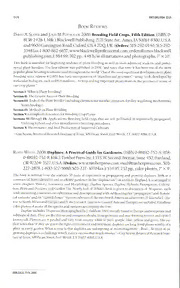
Book Reviews PDF
Preview Book Reviews
1174 BRIT.ORG/SIDA 22(2) Book Reviews D/\v]D A. and M. Pohhlman. 2006. Breeding Field Crops, Fifth Edition. (ISBN 0- Si.i'iM-R Joi in 8138-2428-1, Blackwell Publishing. 2121 Ames, lA 50014-8300, hbk.). State Ave., U.S.A. 0X4 and 9600 Garsuigton Road, Oxford. 2DQ, UK. (Orders: 515-292-0140, 515-292- 3348 fax 1-800-862-6657, www.blackwellprofcssional.com, [email protected] publishing.com,). $84.99, 392 448 b/w illustrations and photographs, 7" x 10". pp., This book is intended lor beginning srudenrs of plant breeding as well as more advanced students and profes- The was sional plant breeders. first edition published ni 1959, "and since that time has been one of the most it popular plant breedhig textbooks used throughout the world." One of most significant developments plant tiie in breeding since edition 4 (1995) has been incorporation of "translational genomics"— using "tools developed by DN A map many molecular biologists, such as markers, to and tag important plants traits on the genomes of of ... our crop plants," What Section Plant Breeding^ 1: is The Section Genetic Basis of Plant Breeding II: chromosome Section Tools of the Plant Breeder (includhig number, mutation, mechanisms, III: fertility-regulating biotechnology) Section Methods Plant Breeding IV: in Section V: Germplasm Resources for Breeding Crop Plants Sections VI through [X: Applications: Breedmg field crops that are self-pollinated or vegetativcly propagated; Utilizing hybrid and cither miscellaneous breeding procedures Section X: Maintenance and Seed Production of Improved Cultivars -Guy Ncsom, Botanical Research Instiluic ojTexas, 509 Pecan Foil Worth, TX76102-4068, St reel, U.S.A. A Robin Wi-iiTr. 2006. Daphnes: Practical Guide for Gardeners. (ISBN 0-88192-752-X, 978- 0-88192-752-8, hbk.). Timber Press Inc, 133 S.W Second Avenue, Suite 450, Portland, OR 97204-3527, U.S.A. (Orders: www.timberpress.com, [email protected], 503- 227-2878, 1-800-327-5680. 503-227-3070 $34.95, 232 color photos, 7" x 9". fax.). pp., The book is written iram the author's 30 years of experience in propagating and growing daphnes, both as a commercial and home horticulturalist as a gardener (in his ^'daphnetum") in southern England. arranged in It is seven chapters; History Taxonomy, and Morphology; Daphne Species, Daphne Hybrids; Propagation; Cultiva- tion; Pests and Diseases; and Garden Use, Nearly half of Whites book given to discussion of 36 species, each is with interesting comments on cultivation and description and with subheadings "propagation" and "botani- for cal variants" and/or "named clones." Various cultivars of the two North American adventives, D. laureola (na- L. tive to North Africa and Europe) and D. mezereum L. (native to Central Asia and Europe), are included. Excellent many color photos of of the species and variants accompany the text. m Daphne includes 70 species (monographed by Halda in 2001) mainly found Europe and temperate and J. subtropical Asia. They are deciduous and evergreen shrubs, from prostrate and mat-forming to erect and up to 5 meters tall. Flowers are 4-petaled and vary from creamy white to pink, purple, hlac, yellow, and green. The au- thor notes that "if tliey are given the right environment and treatment, daphnes are long-lived plants worthy of a m What place every garden. is true is that daphnes are unforgiving of mismanagement [but] To most of us, ... ... growing daphnes a challenge which makes success that much sweeter."— Guy Nesom, Botanical Research is Insti- TX lute of Texas, 509 Pecan Street, Fort Worth, 76102-4068, U.S.A. SIDA22(2);n74.2006
